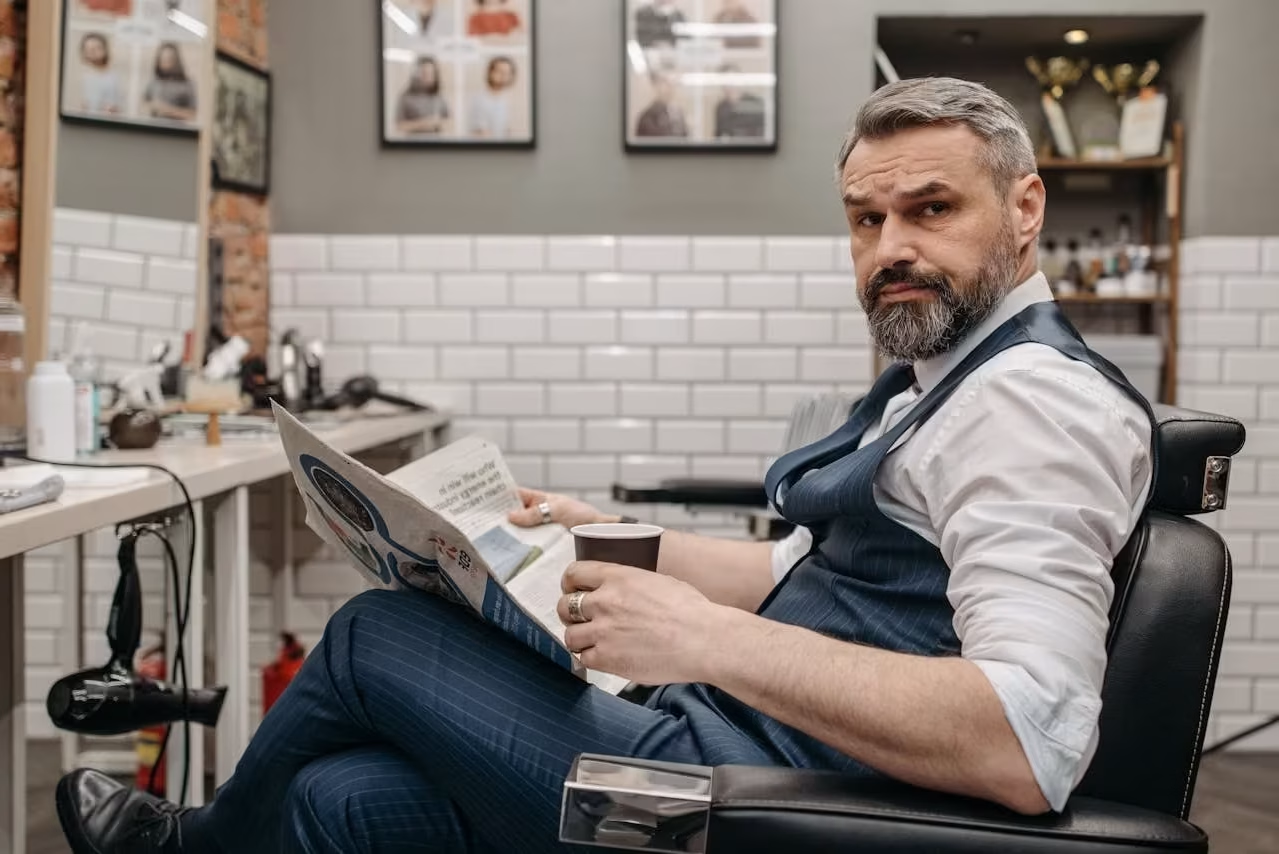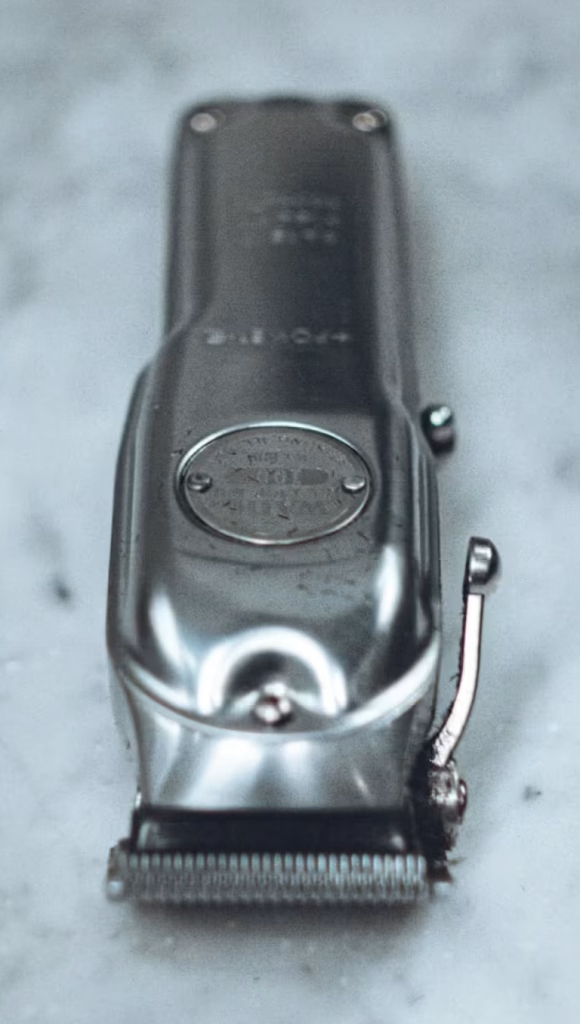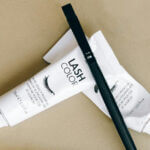
Do you want to grow out your gray hair without telling the world you’ve been coloring it for years? If so, you don’t want obvious regrowth, and you don’t want a sudden change of color.
Whether it’s the hair of your head, your face, or both, it should be a discreet transition. And because you may not know the true extent of your gray or how it will make you look, it’s important that you have full control over how much you reveal.
Will Gray Hair Make You Look Old?
We tend to associate graying with the elderly. Maybe that’s why you decided to dye in the first place.
But it won’t age you if you’re still young. For example, I know two men in their late 30s: one salt-and-pepper and one completely white. The gray only enhances their stylish good looks.
Nor will it make you less attractive if you’re older. But it could draw attention to your maturity.
And the same is true of a dye that is too dark for your complexion.
Not only does our hair lose pigment with age; so does our skin. Of course, there are people who never go gray, but their overall coloring still pales.
In other words, if your hair is dyed the same saturated hue nature blessed you with as a 20-year-old, there’ll come a time when it will look artificial.
Why Turn Gray?
But that’s not the only reason to rethink the way you manipulate your hair color: silver is difficult to dye.
If you have more than 25 to 40 percent gray, an easy-to-apply demi-permanent product like Just for Men will prove inadequate. You’ll need a permanent dye. And because gray hair is coarse, you may have to pretreat it in order to improve color distribution and retention.
These are complications most of us can live without.
It’s even worse if you’re in a hot climate. A friend of mine living in Spain found that the sun faded his hair and beard so fast that he couldn’t keep up. In the end he stopped trying and let the gray take over.
Another friend who enjoyed sea swimming found that saltwater turned his dyed black hair a sort of mahogany.
A further problem is disguising regrowth, especially if your natural color is white. Of course, there are root concealers, but it’s still inconvenient.
And there are men who want to emulate a Hollywood heartthrob whose popularity rose only after he turned gray—I won’t mention any names.
Reasons to Keep Coloring
But just because he looks good without dye doesn’t mean you will.
Take me, for example.
The remaining hair on my head is now salt-and-pepper, which doesn’t bother me. But if I don’t darken my brows, I look washed out. And because my mustache is an asymmetrical mix of white, gray, black, and brown, it turns into a scruffy mess if I don’t even it out.
Therefore, I can’t reveal the true extent of my gray and look good at the same time.
Thinning hair may be another reason to continue coloring. Gray and white will make it appear even sparser, whereas darker tones add volume.

How Long Does It Take to Grow Out Gray Hair After Coloring?
For most people, the growth rate is about six inches per year.
Men generally wear their hair short, so with regular trims you could grow out your gray within a few months of applying a permanent color.
But you might resemble a skunk in the process.
Your closely cut sides and back will already have turned silver while your top lengths remain full of dye. Your beard and mustache won’t be a pretty sight, either.
If you’re using a demi-permanent product that fades after 20 to 30 washes, it may only take a month.
The trouble is, gray doesn’t suit everyone. For example, very pale men need color to vitalize their appearance.
This is why it’s best to proceed slowly and monitor carefully.
| Denotation | Permanence Level (as stipulated on the box) | Duration | Gray Coverage |
| Semi-Permanent or Temporary | 1 | 3 to 12 washes | First grays or less than 25 percent |
| Demi- or Semi-Permanent | 2 | Up to 30 washes | Between 25 and 40 percent |
| Permanent | 3 | The color must grow out | 100 percent |
Shave Your Head
But what if you want to stop coloring immediately?
This too is possible without telling the world you’ve been concealing grays all this time.
If you have a good head shape, shave it. It’s a drastic move, but it’s the fastest way to rid yourself of dye.
Remain bald for a year or two, then grow in your gray little by little, sometimes shaving, sometimes buzzing.
Buzz It
Instead of touching up your monthly regrowth, buzz to about half an inch, which will fully expose your natural color.
It’s not a gradual transition, but there is method to this madness.
Do it just before you go on vacation. It will allow you to see how gray you are, whether it suits you, and how others react to you. Cover it up again before you get back, and decide whether to continue dyeing as usual or develop a transitioning strategy.
Alternatively, use your vacation to begin with a product like Control GX by Just for Men. Available in light and dark, this allows you to gradually blend gray according to how much you wish to reveal. You can treat your facial hair in the same way with Control GX Beard Wash.
When you return to work and your everyday life, people will notice your new buzzcut rather than your faded hair color.
Or, if you’re sure you’ll be happy as a silver fox, buzz it between jobs or before relocating.
Such events are always a good opportunity to alter your appearance, whether it’s revealing the bald pate you’ve been concealing for years, growing a beard or mustache, or going gray.
Hair Color Remover
There is such a thing as hair color remover, but I don’t recommend it.
These are sulfur-based stripping products that can easily damage the hair without returning it to a natural color. Worse still, if you dye afterward, results can be unpredictable.

How to Discreetly Grow Out Gray Hair That Has Been Colored
If you have time to transition gradually, your hair should appear increasingly faded and ashen over a period of months—or longer if you wish. Eventually, you may decide to stop dyeing altogether. Or, if you find that you look too washed out, continue covering only a certain amount of gray.
As a man, your salt-and-pepper doesn’t have to be perfectly even. Look at the model at the top of this post.
A pristine snowy white isn’t necessary, either.
In other words, you won’t need meticulously placed highlights and lowlights to disguise regrowth and balance color. So don’t worry about sitting in a hairdressing salon for hours on end with foils on your head.
You can save time, money, and your reputation by doing it in the privacy of your own home.
You’ll only need to visit your barber for a trim once every three weeks. Best for graying hair is a layered cut.
1. Change Your Hair Color
The first thing to do is swap your regular color for an ash tone. Lacking red pigment, this will appear less saturated and blend with your emerging grays.
To blend medium to dark brown hair, opt for dark ash blond. Medium ash is for lighter shades. Although technically blond, these are by no means light.
You can also mix colors for a more exact match; for example, light with medium.
2. Switch Permanence Levels
You won’t need to do this if you’re already using a demi-permanent dye.
For extensive gray (more than 40 percent), continue for a while with a permanent product (in ash), then switch to demi-permanent.
As the permanent dye grows out, the ashier your hair will appear.
3. Begin the Fading Process
When your permanent dye has grown out completely, go a shade lighter with your demi-permanent product. If you’re comfortable with the effect, begin the fading process.
This means leaving longer intervals between treatments.
When the color is too faded for your liking, refresh with Men’s Master Repigmenting Shampoo.
This is a temporary product that darkens white to gray. It’s also a great conditioner that can be applied on top of other dyes as well as dyed over. I still use it to balance the color of my mustache.
Eventually, it should replace your demi-permanent product altogether, by which time you’ll be decidedly gray.
Redheaded Men
Red is always difficult once you start to turn white. To cover it up, only a warm blond will appear natural.
To grow out your white hair, I suggest working with Just for Men’s Control GX for lighter shades. I tried this on a blond friend, but the result was too warm. It could, however, be great for redheads.
Caring for Gray Hair
If you think you’ll never need a coloring product again after growing out your gray hair, think again.
Due to UV rays, silver and white are prone to yellowing. Only regular use of purple shampoos and conditioners can counteract this.
Gray hair is also dry and wiry, which makes it difficult to style. For more on this, take a look at my post How to Care for Men’s Gray Hair.
© 2025 J. Richardson
Related Posts
Disclaimer
The information provided by The Neat and Tidy Man (“we,” “us,” or “our”) on theneatandtidyman.com (the “site”) is for general informational purposes only. While we endeavor to keep the information up to date and correct, we make no representation or warranty of any kind, express or implied, regarding the completeness, accuracy, reliability, suitability, adequacy, validity, or availability of any information on the site. Under no circumstance shall we have any liability to you for any loss or damage of any kind incurred as a result of the use of the site or reliance on any information provided on the site. Your use of the site and your reliance on any information on the site is solely at your own risk.



